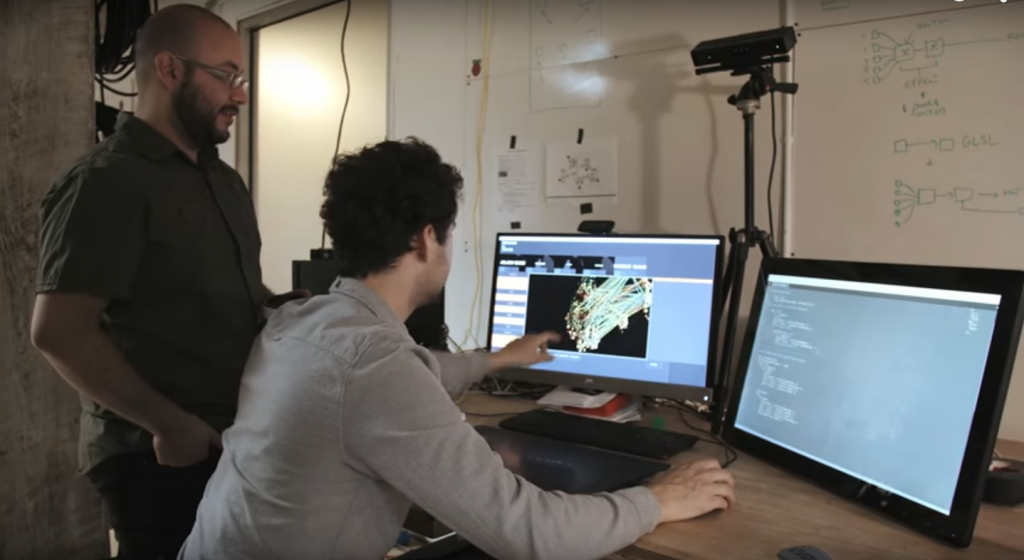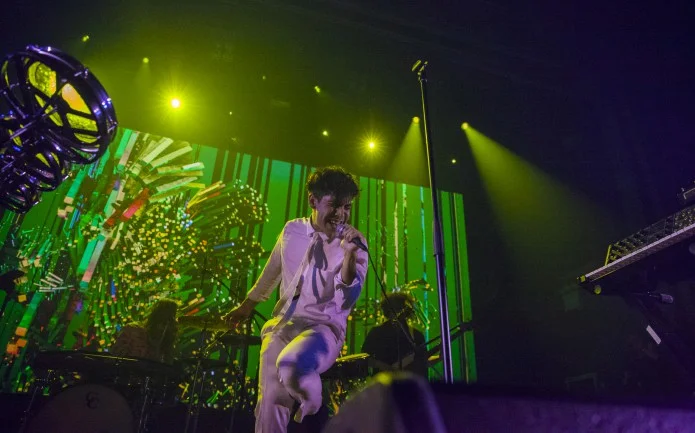VolvoxLabs Shares the Making of their Collaboration with Neon Indian
NEW INC recently caught up with VolvoxLabs’ (VVOX) Pa Her and Kamil Nawratil for a behind-the-scenes look at their creative process. Their latest collaboration, arranged by agency Listen, was with Microsoft and electronic band Neon Indian. The three came together to design an interactive audio-visual experience for Neon Indian's live show, created to compliment the aesthetic of the band's recent album release VEGA INTL. Night School. Inside The Music of Neon Indian was showcased during 2015 CMJ Music Marathon and is VolvoxLabs' third live show, following the Dubfire HYBRID tour and the symphonic BT Electronic Opus show.
For Neon Indian’s CMJ performance, VVOX envisioned a stage environment that would generate live visuals based on the band’s spontaneous movement during their performance. They developed a custom multi-Kinect system to map the movements of Neon Indian’s Alan Palomo and his band. The data was then sent through TouchDesigner before going out to projectors to drive real-time, multi-angle, augmented visual reconstruction onto a large screen.
VVOX created responsive visuals with a unique aesthetic for each song, designed to guide the audience through the performance. The team worked closely with the musicians to develop the visual style with the goal of creating a robust system that was scalable and could be customized for other live performances. To get a better idea of of the process, we interviewed Her and Nawratil about the project.
How do you go from concept to design to production?
The first thing we do is get to know the artist and listen to their set several times. We kicked everything off with Alan Palomo and got to know his style, his vision for the album, and personal aesthetic. Based on this initial analysis, we developed style-frames for each track of the live performance. On top of all the glitch preferences from Alan, we retrieved information from the sensors and added some of our influence with particle movements, dynamic effects and tripped-abstract color palettes.
“While our visual style is driving the entire process, we’re also obsessed with the final image quality. As long as that is coming along, the rest of the process will follow.
”
What is your approach to creating audio-reactive visuals and installations?
Our main goal is to follow the VVOX aesthetic. Our visuals typically show the breaking down or building up of systems, the combination or synthesis of forms (or disciplines), and to show how one is part of the whole. We draw inspiration from dynamic systems in nature, organic structures, and technology. While our visual style is driving the entire process, we're also obsessed with the final image quality. As long as that is coming along, the rest of the process will follow.
There is simply so much more information one can retrieve from a live performance compared to music videos. The information captured from the live performance can drive multiple aspects of responsive content which makes each performance unique every time, instead of creating visuals and cues to already existing work. With the rise of smart technology, there are going to be lots of really exciting opportunities for live performances. We're really looking to push forward with artists and musicians on this front.
What does the art world need to know about the work you do?
Our work truly spans across multiple mediums, we are working personally on every level of the design process starting from concept ideation to digital fabrication, and to retrieving real-time point cloud information. Being able to have a design perspective with the technical language and skills in each of these disciplines help us achieve a streamlined process and more flawless aesthetic.
We're really into responsiveness and cinematic narratives, and definitely looking forward to bringing out our latest ideas to light.
For artists interested in experimenting with live performances, VVOX has a couple tips:
- Know your set-up inside and out: “Even if it worked 1000 times at your studio, most likely it won't when you get to the venue.”
- Make a backup of the backup
- Test the set-up beforehand in two different places
- “Push limits! Don't rely only on technology. Make the the goal of your final output aesthetic your mission.”
Photos by Drew Reynolds



